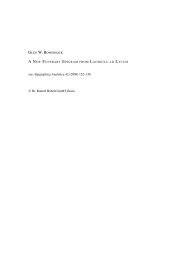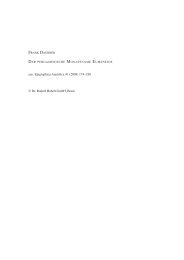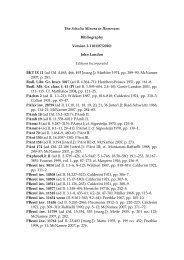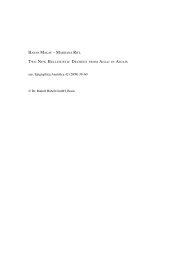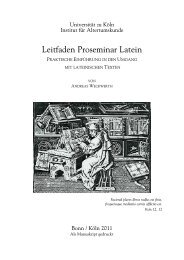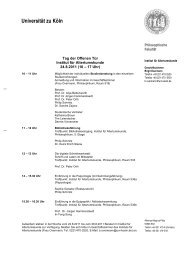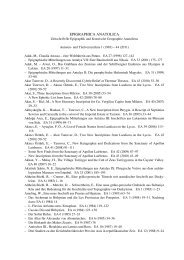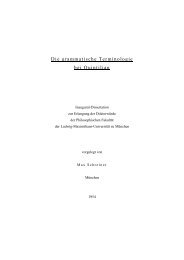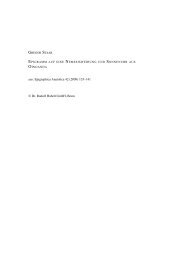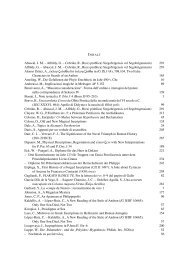Monetary terminology in pre-Roman Asia Minor
Monetary terminology in pre-Roman Asia Minor
Monetary terminology in pre-Roman Asia Minor
You also want an ePaper? Increase the reach of your titles
YUMPU automatically turns print PDFs into web optimized ePapers that Google loves.
SELENE PSOMA<br />
MONETARY TERMINOLOGY IN PRE-ROMAN ASIA MINOR<br />
aus: Epigraphica Anatolica 42 (2009) 170–180<br />
© Dr. Rudolf Habelt GmbH, Bonn
MONETARY TERMINOLOGY IN PRE-ROMAN ASIA MINOR<br />
I. Cistophori <strong>in</strong> Lat<strong>in</strong> Authors and Greek Inscriptions: the Date of the Introduction of<br />
Cistophoric Co<strong>in</strong>age<br />
Cistophoric co<strong>in</strong>age was an <strong>in</strong>novation <strong>in</strong> <strong>Asia</strong> M<strong>in</strong>or. From the late 330s to the early second<br />
century BC currency on the Attic weight standard circulated widely <strong>in</strong> this area. 1 Cistophori were<br />
issued on a lower weight standard with new types: a cista mystica (hence the new name) and a<br />
heavy ivy wreath all around on the obverse and two <strong>in</strong>tertw<strong>in</strong>ed snakes on the reverse. 2 Several<br />
cities of the newly expanded Attalid K<strong>in</strong>gdom struck cistophori “under Attalid supervision”. 3<br />
Because the new co<strong>in</strong>age was <strong>in</strong>troduced with a weight of 12.60 g, 4 25% lower than the Attic<br />
tetradrachm (17.2 g), Attalid <strong>Asia</strong> M<strong>in</strong>or became a closed monetary zone: plentiful hoard evidence<br />
reveals that cistophori did not circulate outside the K<strong>in</strong>gdom and that other co<strong>in</strong>age did<br />
not circulate with<strong>in</strong> the area. 5 On the frontiers of the Attalid K<strong>in</strong>gdom, one silver Attic weight<br />
The author wishes to thank Riet van Bremen, F. de Callataÿ, E. M. Harris, O. Picard and P. Thonemann for<br />
discussion.<br />
1 For Alexanders <strong>in</strong> <strong>Asia</strong> M<strong>in</strong>or see G. Le Rider, Les alexandres d’argent en Asie M<strong>in</strong>eure et dans l’Orient<br />
séleucide au IIIe siècle a.C. (c. 275–225). Remarques sur le système monétaire des Séleucides et des Ptolémées,<br />
Journal des Savants (janvier-septembre 1986) 3–51, pl. I–VI.<br />
2 For the early identifi cation of these co<strong>in</strong>s (<strong>in</strong> 1734) see also W. Szaivert, Der Beitrag der literarischen Quellen<br />
zur Datierung des Beg<strong>in</strong>ns der Kistophorenprägung, NZ 2005, p. 51 n. 5 and 6 (51–64).<br />
3 The number of cities (Pergamum, Ephesus, Tralles, Sardis, Smyrna, Synnada, Apameia, Laodicea, Thyateira,<br />
Stratonicea, Adramyttium) that issued cistophori was <strong>in</strong>creased with G. Le Rider’s studies: Un groupe de cistophores<br />
de l’époque attalide, BCH 114. 2 (1990) 683–701 (Dionysoupolis?, Blaundos? Lysias? Dioskome?); idem,<br />
Monnayage cistophorique des Apaméens, des Praipénisseis et des Corpéni sous les Attalides. Questions de géographie<br />
historique, BCH 115.1 (1991) 361–376 (Praipenissos, Korpenoi). For a list of cities that struck cistophori under<br />
the Attalids and later under the <strong>Roman</strong>s see G. Le Rider, BCH 115.1 (1991) 365 with n. 8. As far as we know, the<br />
only cities which issued both currencies, cistophori and Attic weight tetradrachms, were Smyrna and Ephesus: on<br />
Smyrna see J. G. Milne, The Autonomous Co<strong>in</strong>age of Smyrna II, NC 1927, 46 nos. 186–189 (1–107, pl. I–V) and<br />
Ph. K<strong>in</strong>ns, ‘<strong>Asia</strong> M<strong>in</strong>or’, <strong>in</strong> CRWLR 108 n. 25 (105–119). On Ephesus see F. S. Kle<strong>in</strong>er, The Dated Cistophori of<br />
Ephesus, ANSMN 18 (1972) 17–32. For both cities, other Attic weight currencies issued by cities such as Tralles,<br />
and other issu<strong>in</strong>g authorities <strong>in</strong> the Attalid K<strong>in</strong>gdom see also G. Le Rider, La politique monétaire du royaume de<br />
Pergame après 188, Journal des Savants (juillet-décembre 1989) 173 (163–189), pl. I. For the so-called cistophoric<br />
countermarks see P. Thonemann, Cistophoric Geography: Toriaion and Kormaia, NC 168 (2008) 43 ff.<br />
4 Le Rider, La politique monétaire (n. 3) 164–169.<br />
5 See Le Rider, La politique monétaire (n. 3) 181; R. H. J. Ashton, The Co<strong>in</strong>age of O<strong>in</strong>oanda, NC 165 (2005) 73<br />
(65–84). A number of hoards buried <strong>in</strong> 2nd century <strong>Asia</strong> M<strong>in</strong>or br<strong>in</strong>g evidence on that direction. These are: IGCH<br />
1326 (Balikesir, Mysia 1958), 1327 (anc. Ceraseis, Mysia 1963), 1328 (Euhippe, Caria 1952) 1330 (Priene, Ionia,<br />
1895–8), 1340 (Smyrna, Ionia 1865), 1358 (Miletopolis, Mysia 1929; see also CH V 52), 1452 (<strong>Asia</strong> M<strong>in</strong>or 1876),<br />
1455 (<strong>Asia</strong> M<strong>in</strong>or 1928), 1456 (<strong>Asia</strong> M<strong>in</strong>or 1971), 1458 (<strong>Asia</strong> M<strong>in</strong>or 1955), 1459 (<strong>Asia</strong> M<strong>in</strong>or 1935), 1460 (<strong>Asia</strong><br />
M<strong>in</strong>or 1970), 1461 (<strong>Asia</strong> M<strong>in</strong>or 1996), 1462 (<strong>Asia</strong> M<strong>in</strong>or 1961), 1466 (<strong>Asia</strong> M<strong>in</strong>or bef. 1722), 1467 (<strong>Asia</strong> M<strong>in</strong>or<br />
1868). See also G. Le Rider, Sur un aspect du comportement monétaire des villes libres d’Asie M<strong>in</strong>eure occidentale<br />
au IIe siècle: leurs émissions de tétradrachmes de poids attique frappées entre 188 et c. 140, <strong>in</strong> Les cités d’Asie<br />
M<strong>in</strong>eure occidentale au IIe siecle a.C., edited by A. Bresson and R. Descat, Paris–Bordeaux 2001: 37–59, pls. I–III;<br />
CH II 94 (Ionia 1974), 130 (Turkey); CH VIII 525 (<strong>Asia</strong> M<strong>in</strong>or 199/92), 537 (unknown fi ndspot, before 1986), 539<br />
(<strong>Asia</strong> M<strong>in</strong>or 1988); CH IX 535 (anc. Colophon 1973). See also CH II 113 and V 56 for discussion and bibliography.<br />
For IGCH 1453 (<strong>Asia</strong> M<strong>in</strong>or 1962), which conta<strong>in</strong>s cistophori and Attic weight co<strong>in</strong>ages (philetairoi of Westermark<br />
group VII) see Le Rider, La politique monétaire (n. 3) 177–178: “aux confi ns du territoire de Pergame”.
<strong>Monetary</strong> Term<strong>in</strong>ology <strong>in</strong> Pre-<strong>Roman</strong> <strong>Asia</strong> M<strong>in</strong>or 171<br />
tetradrachm was most probably exchanged for one silver cistophorus with a 25% ga<strong>in</strong>, just as <strong>in</strong><br />
Ptolemaic Egypt. 6<br />
Hoard and other evidence <strong>in</strong>dicate a date between 185–180 and 175–170 for the <strong>in</strong>troduction<br />
of the cistophori. 7 This evidence appears to clash with the mention of cistophori by Livy <strong>in</strong> his<br />
description of <strong>Roman</strong> triumphs dur<strong>in</strong>g the very early second century BC. 8 In four places Livy<br />
mentioned cistophori <strong>in</strong> the loot taken by the <strong>Roman</strong>s: M. Acilius Glabrio over Antiochos III<br />
and the Aetolians <strong>in</strong> 190 (37.46.3), the naval triumph of L. Aemilius Lepidus over Antiochos III<br />
<strong>in</strong> 189 BC (37.58.4), the triumph of L. Cornelius Scipio over Antiochos III <strong>in</strong> 189 BC (37.59.4)<br />
and of Cn. Manlius Vulso over the Galatians <strong>in</strong> 187 BC (39.7.1). 9 Two problems then arise. (A)<br />
If we date, with G. Le Rider et alii, the <strong>in</strong>troduction of the cistophori <strong>in</strong> the years immediately<br />
follow<strong>in</strong>g the peace of Apamea, how then can we expla<strong>in</strong> the mention of the cistophori by Livy<br />
<strong>in</strong> his account of events before the peace of Apamea? (B) The hoards show that cistophori never<br />
circulated <strong>in</strong> Ma<strong>in</strong>land Greece; why then do they appear <strong>in</strong> the loot of M. Acilius Glabrio at<br />
Thermopylae <strong>in</strong> Ma<strong>in</strong>land Greece?<br />
Because Greek literary sources never mention the cistophori as a monetary unit (all available<br />
evidence concerns the signifi cance of the word kistophoros as a basket bearer <strong>in</strong> a religious<br />
context), 10 to solve this problem one must turn to contemporary epigraphic evidence from <strong>Asia</strong><br />
M<strong>in</strong>or and Ma<strong>in</strong>land Greece. L. Robert thought that this monetary unit could be recognized <strong>in</strong> a<br />
heavy damaged <strong>in</strong>scription of fi rst century BC date from Sardis. 11 However, the religious context<br />
of this <strong>in</strong>scription and the use of the dative for both theois and kistophorois proves that the term<br />
surely refers to basket-bearers. The <strong>in</strong>itial letters κισ- of the monetary unit, κιστοφόρος, can be<br />
recognized <strong>in</strong> a late Hellenistic list of contributions from Magnesia near Sipylon, as L. Robert<br />
po<strong>in</strong>ted out. 12 From the last l<strong>in</strong>es of a list of donations of second/fi rst century BC date from Priene,<br />
6 On Ptolemaic Egypt see Le Rider (n. 1).<br />
7 Le Rider (n. 4) 163–169 with discussion and bibliography. See also G. Le Rider – Fr. de Callataÿ, Les Séleucides<br />
et les Ptolemées. L’héritage monétaire et fi nancier d’Alexandre le Grand (Paris 2006) 183.<br />
8 See <strong>pre</strong>vious note and W. Szaivert (n. 2) 51–64: After close exam<strong>in</strong>ation of all Lat<strong>in</strong> literary evidence, Szaivert<br />
concluded that “die literarische Überlieferung für die Datierung des Beg<strong>in</strong>ns der Kistophorenprägung ke<strong>in</strong>e<br />
Relevanz hat und daher aus der Diskussion auszuscheiden ist, wie es ja schon – allerd<strong>in</strong>gs ohne Begründung –<br />
Mommsen getan hat” (p. 62). Cistophori are also mentioned by Sextus Pompeius Festus (359, 22 M.) and Cicero<br />
(Dom. 52, 6; Att. 2, 6, 2; 2, 16, 4; 11, 1, 2).<br />
9 The discussion on the date of the <strong>in</strong>troduction of the cistophori is rather long and was led by important specialists<br />
of <strong>Asia</strong> M<strong>in</strong>or. For full bibliography and discussion see G. M. Cohen, The Hellenistic Settlements <strong>in</strong> Europe,<br />
the Islands, and <strong>Asia</strong> M<strong>in</strong>or (Berkeley–Los Angeles–London 1995) 236–237 and Le Rider – de Callataÿ (n. 7) 183<br />
with n. 1. R. H. J. Ashton, The Co<strong>in</strong>age of Rhodes 408 – c. 190 BC, <strong>in</strong> Money and its Uses <strong>in</strong> the Ancient Greek<br />
World, A. Meadows and K. Shipton eds (Oxford 2001) 79–115 tried a reconciliation of the op<strong>in</strong>io communis that<br />
dates the <strong>in</strong>troduction of the cistophori <strong>in</strong> the years follow<strong>in</strong>g Apamea and the mention of cistophori by Lat<strong>in</strong><br />
authors. He suggested that “the cistophori and the Rhodian pl<strong>in</strong>thophori may have been coord<strong>in</strong>ated on the same<br />
standard and <strong>in</strong>troduced <strong>in</strong>itially to meet expenditure <strong>in</strong> the war aga<strong>in</strong>st Antiochos III”: Hellenistic <strong>Asia</strong> M<strong>in</strong>or,<br />
A Survey of Numismatic Research 1996–2001 (Madrid 2003) 135 (133–150). For the date of the <strong>in</strong>troduction of<br />
Lycian pl<strong>in</strong>thophoroi see R. H. J Ashton, Recent Epigraphic Evidence for the Start of the Rhodian and Lykian<br />
League Pl<strong>in</strong>thophoroi, NC 165 (2005) 85–89.<br />
10 Harpocr. (= Photios and Suda s.v.) s.v.; Scholia <strong>in</strong> Demosthenem 18.296; Anthol. Graec. Epigrammata sepulchralia<br />
519. 2.<br />
11 ISard. 195: [- - - θ]ε οῖς ἔ λαιο[ν() - - -] / [- - - ἐ]π᾽ ἐνιαυτῷ· [- - -] / [- - - τ]οῖς κιστοφόρ[οις - - -] / [- - -] τοῖς<br />
θεοῖς [- - -]. L. Robert, Etudes de numismatique grecque 177.<br />
12 J. Keil – A. von Premerste<strong>in</strong>, Bericht über e<strong>in</strong>e Reise <strong>in</strong> Lydien und der südlichen Aiolis (Wien 1908) no. 14:<br />
ἐπηνγίλαντο εἰς τὴν --- ἐπανώρ(θ)oσιν. The fi rst l<strong>in</strong>e of the voluntary payments is <strong>pre</strong>served; the amounts were
172 S. Psoma<br />
we learn that a prom<strong>in</strong>ent citizen, Poseidonios son of Andron, grandson of Epi kouros and adoptive<br />
son of Menandros, promised to give one hundred and sixty cistophori: [το]ῖς συνβάκχοις εἰς<br />
τὸ[ν / ἀγορ]ασμὸν τοῦ προσκει/[μένου] τῷ βακχικῷ τόπου κισ/[τοφόρ]ους ἑκατὸν ἑξήκον[τα]. 13<br />
The way the monetary term cistophori is used <strong>in</strong> the list of donations from Priene, <strong>in</strong> the<br />
accusative plural, does not allow us to determ<strong>in</strong>e whether the term refers to staters or drachms.<br />
There are two ways to expla<strong>in</strong> the term kistophoroi <strong>in</strong> the <strong>pre</strong>viously mentioned list of contributions<br />
from Priene: (a) kistophoroi refer to drachms (kistophorous drachmas) or (b) to staters (kistophorous<br />
stateres). Drachms – fourths of cistophori – were struck with lion’s sk<strong>in</strong> hang<strong>in</strong>g over<br />
a club on an oak-wreath on the obverse and a bunch of grapes on v<strong>in</strong>e-leaf on the reverse. 14 Thus,<br />
these drachms could not be called kistophoroi because they do not bear a cista mystica. There is<br />
then only one possibility: the term kistophoroi refers to staters. One should recall that the Lat<strong>in</strong><br />
authors who mention this co<strong>in</strong>age always use the adjective <strong>in</strong> the mascul<strong>in</strong>e form.<br />
Thus the term cistophori refers to staters. All around the Greek world, stater refers to the<br />
heaviest co<strong>in</strong> of a monetary system and standard. 15 The fi rst co<strong>in</strong>s with the weight of an Attic<br />
tetradrachm were issued by Euboean cities and they were called staters <strong>in</strong> contemporary <strong>in</strong>scriptions<br />
from Eretria. 16 It was also the case <strong>in</strong> the Chalcidic pen<strong>in</strong>sula (Sermylia), an area under<br />
strong Euboean <strong>in</strong>fl uence <strong>in</strong> the early fi fth century BC. 17 Athenian documents of the 420s mentioned<br />
the staters of Akanthos. 18 These are the well-known Euboean-Attic weight “tetradrachms”<br />
that were issued <strong>in</strong> large quantities dur<strong>in</strong>g the early fi fth century BC. In fourth century BC<br />
Thasos, the term stater was used for the heaviest silver co<strong>in</strong>s struck after the reform of 390 BC;<br />
as a result there are Thasian staters of 14.4 g and drachms of 3.6 g. 19 All currencies <strong>in</strong> Ma<strong>in</strong>land<br />
Greece with the exception of the Attic tetradrachms were called staters where the TMSO (talentm<strong>in</strong>a-stater-obol)<br />
system was reta<strong>in</strong>ed to the beg<strong>in</strong>n<strong>in</strong>g of the fi rst century BC. 20 It is <strong>in</strong>terest<strong>in</strong>g<br />
to note that <strong>in</strong> Cretan <strong>in</strong>scriptions of Late Hellenistic date, Attic tetradrachms are also called<br />
calculated <strong>in</strong> cistophori and the letters iota and sigma (lunar) were written above the kappa. Keil and von Premerste<strong>in</strong><br />
noted: “Buchstaben der späthellenistischen Zeit”. Cf. L. Robert, Quelques monnaies dans les <strong>in</strong>ventaires de<br />
Délos athénienne, Etudes de numismatique grecque (1951) 177 and notes 2 and 3 (143–178).<br />
13 SEG XXXI 983; IPriene 209. As the editor pr<strong>in</strong>ceps H. Malay (RA 1981, 77–78) rightly po<strong>in</strong>ted out “here the<br />
cistophori of the prov<strong>in</strong>ce are meant”.<br />
14 F. S. Kle<strong>in</strong>er, The Early Cistophoric Co<strong>in</strong>age (New York 1977) 21.<br />
15 S. Psoma, Σταθμητικοί κανόνες στην Χαλκιδική κατά τον 5 ο και 4 ο αι. π.Χ., Οβολός 4 (2000) 25–36.<br />
16 E. van Effenterre, Recueil d’<strong>in</strong>scriptions politiques et juridiques de l’archaisme grec, Nomima I (1994) 91:<br />
texts 1 and 3. See also H. Nicolet-Pierre, Epigraphie et numismatique: quelques remarques sur les noms de monnaies<br />
dans les <strong>in</strong>scriptions grecques archaïques, Numismatic Archaeology, Archaeological Numismatics (ed. K. A.<br />
Sheedy and Ch. Papageorgiadou-Banis). Proceed<strong>in</strong>gs of an International Conference held to honour Dr. Mando<br />
Oeconomides <strong>in</strong> Athens 1995 (Oxford 1997) 70–76.<br />
17 Psoma (n. 15).<br />
18 IG I 3 383 1 face A col. II fr. VIII 178.<br />
19 e O. Picard, Monnayage thasien du V siècle avant Jésus-Christ, CRAI 1982, 412–418; S. Psoma, Notes sur la<br />
term<strong>in</strong>ologie monétaire en Grèce du Nord, Journée organisée par la Société Française de Numismatique en l’honneur<br />
d’Hélène Nicolet-Pierre, RN 2006, 93 (85–98).<br />
20 J. Bousquet, Les unités monétaires dans les comptes de Delphes, BCH 11 (1986) 273–283 (= Etudes sur les<br />
comptes de Delphes [Paris 1988] 185–199); id., Bull. ép. 1996, 221; D. Mulliez, Le denier dans les actes d’affranchissement<br />
delphique, Topoi 7 (1997) 94 and 102 (93–102).
<strong>Monetary</strong> Term<strong>in</strong>ology <strong>in</strong> Pre-<strong>Roman</strong> <strong>Asia</strong> M<strong>in</strong>or 173<br />
staters. 21 The offi cial name of the so-called Ptolemaic tetradrachm was stater; they are mentioned<br />
<strong>in</strong> this way <strong>in</strong> papyri from Ptolemaic Egypt where these silver co<strong>in</strong>s were legal tender. 22<br />
In <strong>in</strong>scriptions of <strong>Asia</strong> M<strong>in</strong>or the term stater occurs from the late sixth century BC to the<br />
fi rst century AD. This term had a long history and designated different co<strong>in</strong>s <strong>in</strong> different cities. 23<br />
The issu<strong>in</strong>g authority of the staters is very rarely noted: <strong>in</strong> <strong>in</strong>scriptions from Ionia, Mysia and<br />
Troas, the areas we are <strong>in</strong>terested <strong>in</strong>, the adjectives Phokaeus (of the Phokaians), Darikos (with<br />
Dareius’ types) and also chrysous occur <strong>in</strong> very few cases and denote foreign (and <strong>in</strong>ternational)<br />
currencies. 24 These are really exceptions to the rule. Staters are generally mentioned without any<br />
<strong>in</strong>dication of their issu<strong>in</strong>g authority or their metal and refer to the heaviest co<strong>in</strong> of a monetary<br />
system and standard. 25 Thus, different currencies issued by different issu<strong>in</strong>g authorities were<br />
meant by this term, each of them referr<strong>in</strong>g to its own currency for which Samos used additionally<br />
the adjective patrios (stater patrios) around 250 BC (IG XII, vi 1, 172, 8). 26<br />
This reveals the signifi cance of the term stater <strong>in</strong> monetary <strong>term<strong>in</strong>ology</strong> of the Ancient Greek<br />
world. While stater seems to be the term par excellence for the biggest silver denom<strong>in</strong>ation, the<br />
term tetrachmon is less frequent. 27 It is totally absent from <strong>Asia</strong> M<strong>in</strong>or <strong>in</strong>scriptions. In Ma<strong>in</strong>land<br />
Greece, it refers to currencies of Attic weight that were issued dur<strong>in</strong>g the Hellenistic period.<br />
It occurs only <strong>in</strong> very few cases outside Athens and areas under its <strong>in</strong>fl uence such as Oropos,<br />
Me gara and Delos. 28 At Delos, a place under Athenian <strong>in</strong>fl uence and Athenian territory after<br />
167 BC, this term is used to denote large silver denom<strong>in</strong>ations. This is the reason the terms kistophora<br />
or kissophora 29 tetrachma that denote cistophori <strong>in</strong> the Delian <strong>in</strong>ventories dat<strong>in</strong>g after<br />
167 BC can not be considered as direct evidence for the monetary term to which cistophorus<br />
referred to. 30 In the Delian <strong>in</strong>ventories under the Athenians, the differences of weight or the offi -<br />
cial names of the co<strong>in</strong>s were not taken <strong>in</strong>to consideration because the cistophori were foreign<br />
21 IC I viii 13 l. 21: treaty between Hierapytna and Cnossus, second century BC.<br />
22 H. Caddell – G. Le Rider, Prix du blé et numéraire dans l’Egypte lagide de 305 à 173, Papyrologica Bruxellensia<br />
30 (Bruxelles 1997) 20, 34, 60; F. Burkhalter – O. Picard, Le vocabulaire fi nancier dans les papyrus et<br />
l’évolution des monnayages lagides en bronze, <strong>in</strong> F. Duyrat et O. Picard, L’exception égyptienne? Production et<br />
échanges monétaires en Egypte hellénistique et roma<strong>in</strong>e. Actes du colloque d’Alexandrie, 13–15 avril 2002 (Cairo<br />
2005) 55 (53–80); Le Rider – de Callataÿ (n. 7) 131.<br />
23 S. Psoma (n. 15) 25–36; ead., ΣΤΑΤΕΡ ΜΑΧΟΝ, Nom. Chron. 20 (2001) 13–44; ead. (n. 19) 85–98.<br />
24 For phokaeus see SEG 15. 751, l. 1 (G. Daux, Décret de Sigée trouvé en Corse, BCH 80 [1956] 53–56: fi rst half<br />
of the third century BC) and for Darikos, IEphesos 10. l. 30 (summary of an old sacred law concern<strong>in</strong>g sacrifi ces).<br />
25 Psoma (n. 15) 25–36.<br />
26 See commentary ad l. 8 of IG XII, vi 1, 172 with all <strong>pre</strong>vious bibliography.<br />
27 For the term tetrachmon see D. Knoepfl er, Tetradrachmes attiques et argent “alexandr<strong>in</strong>” chez Diogène<br />
Laérce, Mus. Helv. 44 (1987) 233–253; 46 (1989) 193–230. Cf. Bull. ép. 1988, 97 and 1990, 208. See also D.<br />
Knoepfl er, Alexandreion nomisma. L’apparition et la disparition de l’argent d’Alexandre dans les <strong>in</strong>scriptions<br />
grecques. Quelques réfl exions complémentaires, Topoi 7.1 (1997) 33–50.<br />
28 These are: (a) the well known Amphictyonic decree from Delphi on the value of the Attic tetradrachm (CID<br />
IV 127) and (b) the honorary decree of Lycosoura for Damophon. For Delphi see S. Psoma, À propos de drachmes<br />
d’argent du décret amphictyonique CID IV 127, ZPE 160 (2007) 83 n. 36 (79–88).<br />
29 The term kissophora was alternatively used, referr<strong>in</strong>g to the heavy ivy-wreath surround<strong>in</strong>g the cista mystica:<br />
Robert (n. 12) 177 with n. 9.<br />
30 IDélos 1409 1. face B. fr. A col. I 17: 166 BC; IDélos 1430 1. 1. 1. h 13: 153/152 BC; IDélos 1439 1. face Abc.<br />
col. 1. 13: 166–140/139 BC; IDélos 1441 1. 1. face A. fr. col. 1. 45: ca. 150 BC; IDélos 1443 1. 1. face A. col. I 149:<br />
145/144–142/141 BC; IDélos 1449 1. face A. fr. ab. col II. 22: post 166 BC; IDélos 1450 1. 1. 1. face A. 37: 140/139<br />
BC. L. Robert recognized these co<strong>in</strong>s <strong>in</strong> the kistophora and sometimes kissophora tetrachma of the Delian <strong>in</strong>ventories:<br />
Robert (n. 12) 143–178, esp. 168 and 177. For these <strong>in</strong>scriptions see also Le Rider (n. 4) 163 with n. 2.
174 S. Psoma<br />
currency at Delos where only Athenian co<strong>in</strong>age was legal currency, the so-called stephanephora<br />
tetrachma. 31 To describe foreign co<strong>in</strong>ages as the kistophora or kissophora tetrachma that had to<br />
be excluded from local circulation, the Delian <strong>in</strong>ventories followed the Athenian model which<br />
<strong>in</strong>troduced the term stephanephora (tetrachma) and glaukophora (tetrachma) for Athenian new<br />
and old style co<strong>in</strong>ages. 32 Thus, the Delian bureaucracy <strong>in</strong>vented descriptive adjectives deriv<strong>in</strong>g<br />
from the reverse types of foreign co<strong>in</strong>ages and the end<strong>in</strong>g -phoros: 33 the kraterophoroi of Naxos,<br />
the tetrachma ka<strong>in</strong>a taurophora of Eretria, the drachmai pho<strong>in</strong>ikophoroi of Delos etc. 34 In the<br />
Delian <strong>in</strong>ventories, the pl<strong>in</strong>thophoroi (drachmai) for Rhodian currency m<strong>in</strong>ted <strong>in</strong> the second century<br />
BC are also mentioned although this term never occurs <strong>in</strong> offi cial Rhodian documents. 35 The<br />
Delian <strong>in</strong>ventories mention the kistophora (kissophora) tetrachma although these were called<br />
staters <strong>in</strong> the area where they were legal tender. We should recall that Delian <strong>in</strong>ventories also<br />
mentioned the Ptolemaika tetrachma while these co<strong>in</strong>s are called stateres <strong>in</strong> Ptolemaic papyri. 36<br />
We do not know when the term kistophoroi came <strong>in</strong>to offi cial use <strong>in</strong> <strong>Asia</strong> M<strong>in</strong>or. We learn<br />
from the two <strong>in</strong>scriptions mentioned above that it was used offi cially <strong>in</strong> the fi rst century BC. This<br />
is also true for the kitharephoroi of Lycia that are mentioned <strong>in</strong> a private document of similar<br />
date. 37 Thus, referr<strong>in</strong>g to co<strong>in</strong>s <strong>in</strong> this way was “courant”, as L. Robert po<strong>in</strong>ted out. 38 However,<br />
with the exception of the Athenian stephanephora for which the term was fi rst used, the earliest<br />
mentions of kistophoroi and kitharephoroi <strong>in</strong> <strong>in</strong>scriptions from <strong>Asia</strong> M<strong>in</strong>or date only from the<br />
fi rst century BC. We recall that the term pl<strong>in</strong>thophoroi for Rhodian drachms was never used <strong>in</strong><br />
Rhodian documents. We may assume that the descriptive adjective (kistophoros) occurred by<br />
itself, without the monetary term for silver (stater) on the new standard after a period dur<strong>in</strong>g<br />
which both the descriptive adjective and the monetary term or only the monetary term stater was<br />
used. In any case, the term kistophoroi was used to describe staters.<br />
After 133 BC, a number of cities cont<strong>in</strong>ued to issue cistophori. As Ph. K<strong>in</strong>ns observed, “they<br />
served as the co<strong>in</strong>age of the new prov<strong>in</strong>ce”. 39 The creation of the prov<strong>in</strong>ce of <strong>Asia</strong> brought no<br />
apparent change to the silver currency of the region. 40 Later, between 58 and 49 BC, the so-called<br />
proconsular cistophori were struck <strong>in</strong> the most important cistophoric m<strong>in</strong>ts under central super-<br />
31 J. Tréheux, L’adm<strong>in</strong>istration fi nancière des ἐπὶ τὰ ἱερά à Délos: une théorie nouvelle, BCH 115.1 (1991)<br />
249–352.<br />
32 For both terms, stephanephoron and glaukophoron, see L. Robert, Les drachmes du stéphanéphore d’Athènes,<br />
Etudes de numismatique grecque (Paris 1951) 129–132 (105–135). For other descriptive terms created by Delian<br />
bureaucracy see C. Prêtre, Un collier délien, REA 99 (1997) 371–376, sp. 376: «une rigueur dans l’<strong>in</strong>novation term<strong>in</strong>ologique,<br />
particulièrement susceptible».<br />
33 See n. 30.<br />
34 Robert (n. 12) 157–159; id., Monnaies dans les <strong>in</strong>scriptions grecques, RN VI ser. vol. 4 (1962) 7–21.<br />
35 See IDélos 461 face B fr. b 49; 1415.3; 1422.12; 1443 A col I 151; 1449 A fr. ab col. II 12, 24; 1450 A 97, 103.<br />
The term may occur <strong>in</strong> an <strong>in</strong>scription of Didyma, see IDidyma 441.5.<br />
36 See n. 22.<br />
37 Robert (n. 12) 150–152.<br />
38 Robert (n. 12) 177–178.<br />
39 Ph. K<strong>in</strong>ns, <strong>Asia</strong> M<strong>in</strong>or, <strong>in</strong> CRWLR 108 (105–119).<br />
40 K<strong>in</strong>ns (n. 39) 109. For hoard evidence see M. T. Göktürk, Un trésor des monnaies cistophores trouvées à<br />
Izmir, Anatolia Antiqua 5 (1997) 83–85. See also F. de Callataÿ, L’histoire des guerres mithridatiques vue par les<br />
monnaies (Louva<strong>in</strong>-la-Neuve 1997) passim who frequently discusses the role of the cistophori dur<strong>in</strong>g the Mithridatic<br />
wars.
<strong>Monetary</strong> Term<strong>in</strong>ology <strong>in</strong> Pre-<strong>Roman</strong> <strong>Asia</strong> M<strong>in</strong>or 175<br />
vision and rema<strong>in</strong>ed the basic unit of currency. 41 Even after the <strong>in</strong>troduction of the denarius <strong>in</strong><br />
<strong>Asia</strong> M<strong>in</strong>or, “the massive cistophoric re-co<strong>in</strong>ages by Antony and the Augustus” show that “the<br />
cistophoric system was reta<strong>in</strong>ed”. 42 The cistophori therefore rema<strong>in</strong>ed the basic unit of currency<br />
<strong>in</strong> <strong>Asia</strong> M<strong>in</strong>or for a long time after the creation of the prov<strong>in</strong>ce of <strong>Asia</strong>.<br />
We can now turn to the mention of cistophori <strong>in</strong> Lat<strong>in</strong> authors. 43 All the puzzl<strong>in</strong>g passages of<br />
Lat<strong>in</strong> authors become clear, if we <strong>in</strong>ter<strong>pre</strong>t cistophori to mean staters. In <strong>Asia</strong> M<strong>in</strong>or, before the<br />
peace of Apamea and the <strong>in</strong>troduction of cistophori <strong>in</strong> the early second century BC, the <strong>Roman</strong>s<br />
collected Alexandreia tetrachma and local currencies issued on non Attic standards. These, as<br />
the cistophori, were called staters, as we learn from contemporary <strong>in</strong>scriptions. As far as Ma<strong>in</strong>land<br />
Greece and the triumph of M. Acilius Glabrio are concerned, the hero of Thermopylae<br />
brought with him, <strong>in</strong>ter alia, Attica tetrachma and money on the Aeg<strong>in</strong>etan and probably also<br />
the Cor<strong>in</strong>thian standard, which were the ma<strong>in</strong> currencies <strong>in</strong> Greece south of the Olympus dur<strong>in</strong>g<br />
the third century BC. These co<strong>in</strong>s on the Aeg<strong>in</strong>etan, the reduced Aeg<strong>in</strong>etan, the Cor<strong>in</strong>thian<br />
or the reduced Cor<strong>in</strong>thian standards mentioned <strong>in</strong> contemporary <strong>in</strong>scriptions of Central Greece<br />
as staters, 44 were called “cistophori” by Livy, although cistophori never circulated <strong>in</strong> Ma<strong>in</strong>land<br />
Greece. 45<br />
For Livy, a historian who lived and worked under Augustus, the parallel use of the descriptive<br />
contemporary term cistophori and the old offi cial term stater created confusion. 46 Thus, cistophori<br />
became for Livy a term<strong>in</strong>us technicus for describ<strong>in</strong>g non-Attic weight currency <strong>in</strong> southern<br />
Greece and <strong>Asia</strong> M<strong>in</strong>or, as H. Seyrig rightly recognised for <strong>Asia</strong> M<strong>in</strong>or. 47 From that po<strong>in</strong>t of<br />
view, it strongly rem<strong>in</strong>ds one of the use of Philippeios describ<strong>in</strong>g gold co<strong>in</strong>s on Attic standard<br />
by late Antiquity and Byzant<strong>in</strong>e authors. 48 It is not a simple co<strong>in</strong>cidence that Livy used also the<br />
term Philippeioi <strong>in</strong> the relevant passages to describe gold currency on the Attic standard that the<br />
<strong>Roman</strong>s brought with them to their triumphs <strong>in</strong> Rome. As G. Le Rider po<strong>in</strong>ted out follow<strong>in</strong>g E. T.<br />
Newell: «ce terme (sc. philippeios) désignerait alors les statères d’or de poids attique de cette aire<br />
41 K<strong>in</strong>ns (n. 39) 111–112. For these cistophori see also J. Müller, The Chronology of Ephesos Revisited, SNR 77<br />
(1998) 73–80.<br />
42 K<strong>in</strong>ns (n. 39) 112.<br />
43 For a detailed <strong>pre</strong>sentation of money and other goods collected by <strong>Roman</strong>s for their triumphs see W. Szaivert<br />
(n. 2) 53–58.<br />
44 For mention of staters <strong>in</strong> Hellenistic <strong>in</strong>scriptions from Central Greece see IG IX 1, 3, 706 of 280 BC from<br />
Oiantheia, Locris (the «Lokrische Mädchen<strong>in</strong>schrift»); IG IX 1, 267 from Opous, Locris (third/second century<br />
BC). For Aitolia, IG IX 3, 748 of ca. 190 from Delphi and IG IX 12 , 1, 188 of 213/212 BC from Melitaia, part of<br />
Aitolia at that date.<br />
45 For the <strong>pre</strong>sence of one cistophorus <strong>in</strong> the 1968 Larissa hoard see M. Jessop Price, The Larissa 1968 Hoard<br />
(IGCH 237), Kraay Mørkholm Essays. Numismatic Studies <strong>in</strong> Memory of C. M. Kraay and O. Mørkholm, Numismatica<br />
Lovaniensia 10 ed. by G. le Rider et al. (Wetteren 1989) 240 (233–43, pl. LIV–LV).<br />
46 The evidence of Livy on the <strong>in</strong>troduction of the cistophori was considered as anachronistic by R. Thomsen<br />
(Early <strong>Roman</strong> Co<strong>in</strong>age [Copenhagen 1961] 146–148).<br />
47 e H. Seyrig, Monnaies hellénistiques V. Questions cistophoriques, RN 6 série, tome V 1963, (24 n. 1) 23–31:<br />
«Tite Live, par un anachronisme facile à com<strong>pre</strong>ndre, n’a dû compter en cistophores, d’après une de ses sources,<br />
qu’un mélange disparate de monnaies, et son texte ne saurait être traité comme une pièce de comptabilité»; Le<br />
Rider – de Callataÿ (n. 7) 183 n. 1 with discussion and bibliography.<br />
48 G. Le Rider, Monnayage et fi nances de Philippe II. Un état de la question, ΜΕΛΕΤΗΜΑΤΑ 23 (Athènes<br />
1996) 66 n. 7 who is referr<strong>in</strong>g to M. Caltabiano et P. Colace, L’Eponimia monetale: dall’esperianza orientale a<br />
quelle di età ellenistica, NAC 16 (1987) 33–35 (25–46).
176 S. Psoma<br />
géographique (Grèce, Asie M<strong>in</strong>eure, Orient séleucide), qu’ils fussent frappés au nom et aux types<br />
de Philippe II, d’Alexandre, de Lysimaque, de Démétrios Poliorcète ou des rois séleucides». 49<br />
We can conclude that epigraphic evidence from <strong>Asia</strong> M<strong>in</strong>or, an area where cistophori were<br />
legal tender, reveals that this term is used to denote staters. In this way, one can expla<strong>in</strong> all the<br />
puzzl<strong>in</strong>g passages of Livy that mention cistophori <strong>in</strong> historical events antedat<strong>in</strong>g their <strong>in</strong>troduction.<br />
The cistophori were not <strong>in</strong>troduced for the fi rst time to pay for expenses <strong>in</strong>curred dur<strong>in</strong>g the<br />
war aga<strong>in</strong>st Antiochos III; 50 Attic weight currency was much needed for mercenaries and other<br />
expenses <strong>in</strong> case of war <strong>in</strong> this area. 51 The <strong>in</strong>troduction of the cistophori needs to be placed <strong>in</strong><br />
the historical context of the period follow<strong>in</strong>g the peace of Apamea as this was very thoroughly<br />
described by G. Le Rider. 52<br />
II. Other <strong>Monetary</strong> Units <strong>in</strong> Inscriptions from <strong>Asia</strong> M<strong>in</strong>or<br />
As we have already noted, the term tetrachma never occurs <strong>in</strong> <strong>in</strong>scriptions of <strong>Asia</strong> M<strong>in</strong>or. Beside<br />
the term “stater”, we also fi nd the term drachms. We will not discuss the Rhodian drachms that<br />
have already been discussed by specialists of Rhodes and Caria. We will turn to drachmai Antiocheiai,<br />
Alexandreiai and Attikai and to the staters donated to Kyme by Archippe. 53<br />
The drachms of Antiochos III (drachmai Antiocheiai) are explicitly mentioned <strong>in</strong> two <strong>in</strong>scriptions<br />
of Iasos. The fi rst one dates from the late third century BC and is the letter of Queen<br />
Laodike V to the city of Iasos (IIasos 4.24); the Queen’s donation is calculated <strong>in</strong> drachms<br />
issued by her husband, Antiochus III: εἰς προῖκας ταῖς τῶν ἀσθενούντων πολιτῶν θυγατράσιν,<br />
διδόντες μὴ πλέον Ἀντιοχέων δραχμῶν τριακοσίων ἑκάστηι τῶν συνοικιζομένων. The second<br />
<strong>in</strong>scription is a decree of the Dionysiac Artists for the Iasians (IIasos 152. 22) dated to ca. 150<br />
BC. Royal Seleucid currency on the Attic standard issued by Antiochus III, arrived at Iasos dur<strong>in</strong>g<br />
the years of the Seleucid occupation. 54 Iasos relied on this currency as the city never issued<br />
Attic weight currency with Alexander’s types or civic types dur<strong>in</strong>g the second century BC. 55<br />
Thus, the Attic weight drachms of Antiochus the Great were the only currency of <strong>in</strong>ternational<br />
character available at Iasos <strong>in</strong> the years between 160 and 150 BC. It was with this currency of<br />
<strong>in</strong>ternational character that the Dionysiac Artists <strong>pre</strong>ferred to be paid. 56<br />
As we have already noted, <strong>in</strong>scriptions from <strong>Asia</strong> M<strong>in</strong>or never mention tetrachma. The term<br />
Alexandreiai drachmai of a signifi cant number of <strong>in</strong>scriptions from <strong>Asia</strong> M<strong>in</strong>or that date from<br />
the late fourth century BC to the fi rst century BC, served to denote currency (tetradrachms and<br />
49 G. Le Rider, BCH 116.1 (1992) 274; E. T. Newell, The Co<strong>in</strong>age of the Western Seleucid M<strong>in</strong>ts from Seleucus<br />
I to Antiochus III (New York 1941) 398 n. 10.<br />
50 R. H. J. Ashton, Hellenistic <strong>Asia</strong> M<strong>in</strong>or, A Survey of Numismatic Research 1996–2001 (Madrid 2003) 135<br />
(133–150).<br />
51 Le Rider (n. 4) 179.<br />
52 See n. 4.<br />
53 For the terms argyrion and “light Rhodian money” <strong>in</strong> the second century BC “leases” of Mylasa, see R. H.<br />
J. Ashton and G. Reger, The Pseudo-Rhodian Drachms of Mylasa Revisited, Agoranomia. Studies <strong>in</strong> Money and<br />
Exchange Presented to J. H. Kroll, ed. by P. van Alfen (New York 2006) 126–127 (125–150).<br />
54 For the relations of Antiochos III and his wife Laodike with the Carian city of Iasos see J. Ma, Antiochos<br />
III and the Cities of Western <strong>Asia</strong> M<strong>in</strong>or (Oxford, New York 1999) 89, 112, 161, 180–2, 216–7, 230, 232, 334–5.<br />
55 Le Rider (n. 5) 40.<br />
56 S. Psoma, Profi table Networks: Co<strong>in</strong>ages, Panegyris and Dionysiac Artists, Mediterranean Historical Review<br />
22.2, December 2007, 237–255; ead., Panegyris Co<strong>in</strong>ages, AJN 20 (2008) 227–255.
<strong>Monetary</strong> Term<strong>in</strong>ology <strong>in</strong> Pre-<strong>Roman</strong> <strong>Asia</strong> M<strong>in</strong>or 177<br />
drachms) <strong>in</strong> the name and types of Alexander. 57 This currency on the Attic standard was struck<br />
by a number of m<strong>in</strong>ts <strong>in</strong> Western <strong>Asia</strong> M<strong>in</strong>or from the 320s to the end of the third century<br />
BC. 58 Dur<strong>in</strong>g that same period, Alexander’s tetradrachms and drachms circulated widely <strong>in</strong> that<br />
area (and elsewhere) and were very frequently buried <strong>in</strong> hoards. From the last decades of the<br />
third century BC onwards, “Alexanders” became <strong>in</strong>creas<strong>in</strong>gly rare <strong>in</strong> <strong>Asia</strong> M<strong>in</strong>or and Ma<strong>in</strong>land<br />
Greece. 59 They cont<strong>in</strong>ued to be issued down to 170 by some cities of <strong>Asia</strong> M<strong>in</strong>or and afterwards<br />
only by a restricted number of cities all situated on the coast of Black Sea. 60 Alexandreiai drachmai<br />
cont<strong>in</strong>ued to be mentioned <strong>in</strong> a number of <strong>in</strong>scriptions of second and fi rst century date. 61<br />
The earliest mention of Attikai drachmai <strong>in</strong> <strong>in</strong>scriptions from <strong>Asia</strong> M<strong>in</strong>or is <strong>in</strong> the A2 decree<br />
for Archippe (SEG XXXIII 1036, l. 24). All others are of imperial date. 62 As Louis Robert<br />
po<strong>in</strong>ted out, <strong>in</strong> <strong>Asia</strong> M<strong>in</strong>or and almost all around the Greek world, Attikai drachmai mentioned<br />
<strong>in</strong> <strong>in</strong>scriptions of imperial date refer to denarii. It is also <strong>in</strong> literature of that period that the same<br />
term Attikai is used for the denarii. 63<br />
The mention of the term Attikai drachmai <strong>in</strong> this decree for Archippe <strong>pre</strong>sents special <strong>in</strong>terest<br />
because it refers to the contemporary Attic-weight currency struck by the city with its own<br />
types and ethnic <strong>in</strong> the 150s. 64 The adoption of this term Attikai drachmai for the currency on<br />
the Attic standard issued by the city of Kyme ca. 150 BC with its own types and legend can be<br />
57 D. Knoepfl er has conv<strong>in</strong>c<strong>in</strong>gly shown that the terms Alexandreia tetrachma and Alexandreiai drachmai<br />
mentioned <strong>in</strong> literary sources and <strong>in</strong>scriptions from the late fourth century BC to the fi rst century BC refer to the<br />
co<strong>in</strong>age issued by Alexander, his successors and a number of cities with the types and name of Alexander: see D.<br />
Knoepfl er, Topoi 7.1 (1997) 33–50 and 33 n. 1 for <strong>pre</strong>vious bibliography (n. 27).<br />
58 See n. 1.<br />
59 See n. 1.<br />
60 See M. Jessop Price, The Co<strong>in</strong>age <strong>in</strong> the Name of Alexander the Great and Philip Arrhidaeus: a British<br />
Museum Catalogue. 2 vols. (Zurich, London 1991) 173–174.<br />
61 D. Knoepfl er dressed a list of second and fi rst century BC epigraphic documents mention<strong>in</strong>g Alexandreiai<br />
drachmai: see n. 57.<br />
62 rd IG XII 1, 94 (Rhodos, “aet. Rom.”); ICos 357 l. 5; IPrusias 72 l. 18; TAM V 665 l. 12–13 (Lydia, 3 century<br />
AD); V 2, 866 l. 4 (Thyateira, 3rd century AD); V 2, 1076 l. 4 (Thyateira, 3rd century AD); V 2, 1149 l. 3 (Thyateira,<br />
244–247 AD); II 1–3, 330 l. 12–13 (Xanthos, Lycia: 3rd century AD); MAMA 4, 31 l. 2 (Phrygia); 6. 335<br />
l. 11 (Akmonia); M. Waelckens, Die kle<strong>in</strong>asiatischen Türste<strong>in</strong>e: typologische und epigraphische Untersuchungen<br />
der kle<strong>in</strong>asiatischen Grabreliefs mit Sche<strong>in</strong>tür (Ma<strong>in</strong>z am Rhe<strong>in</strong> 1986) 480 (Phrygia, 215–220 AD); AAT<br />
101.1966/67.304. 22 l. 4 (Hierapolis): non vidi; G. Reimer, Altertümer von Hierapolis (Berl<strong>in</strong> 1898) 148 l. 5, 149 l. 6,<br />
324 l. 1; SEG 16. 753 l. 10 (Dorylaion, Phrygia); ILampsakos 12 l. 8; G. Radet et H. Lechat, Inscriptions du temple<br />
de Zeus Panamaros, BCH 11 (1887) 373–404, sp. 398 l. 7 (Kaikos, after 212 AD); J. G. C. Anderson, Festivals of<br />
Men Askaenos <strong>in</strong> the <strong>Roman</strong> Colonia at Antioch of Pisidia, JRS 3 (1913) 267–300 sp. 284, no. 11 frg. f. 7 (Pisidia);<br />
SEG 2. 733 l. 8 (Pisidia); G. Radet, Inscriptions de Lydie, BCH 11 (1887) 445–484, sp. 481, no. 62 l. 5 (upper Kaikos,<br />
3rd c. AD); A. Conze und C. Schuchhardt, Die Arbeiten zu Pergamon 1886–1899, MDAI 24 (1898) 97–240<br />
sp. 178, no. 30 l. 13 (Pergamum, 18/17 BC–14 AD); IEphesos 26 l. 10 and 3058 l. 10; MAMA 8, 571 (Aphrodisias<br />
438); 547. 5 (Aphrodisias 535); IMylasa 465 l. 8 and 9; R. Heberdey – A. Wilhelm, Reisen <strong>in</strong> Kilikien (= DAN 44.<br />
6 [1896] 125, 202) l. 7. See also follow<strong>in</strong>g note.<br />
63 Robert, RN 1962 (n. 34), 11–13; id., D’Aphrodisias à la Lycaonie. Compte rendu du volume VIII des Monumenta<br />
<strong>Asia</strong>e M<strong>in</strong>oris Antiqua, Hellenica XIII (Paris 1965) 211 n. 2; id., Les <strong>in</strong>scriptions de Thessalonique, RPhil<br />
1974, 217 n. 224 (180–246). See also Bull. ép. 1976, 85, 136, 360 (Thessaloniki); 1974, 579 n. 75 (Nicomedia).<br />
64 Contemporary dates are proposed for the decrees for Archippe and the Attic-weight currency of the city<br />
with solid arguments by R. van Bremen (The Date and Context of the Kymaian Decrees for Archippe (SEG 33.<br />
1035–1041), REA 110.2 (2008) 362–369 (357–382). For monetary units <strong>in</strong> the decrees for Archippe see O. Picard,<br />
Monétarisation et économie des cités grecques à la basse période hellénistique: la fortune d’Archippè de Kymè,<br />
Approches de l’économie hellénistique, EAHSBG 7 (2007) 85–119.
178 S. Psoma<br />
easily expla<strong>in</strong>ed if we recall that the city struck currency on the Attic standard with the name and<br />
types of Alexander III from ca. 215 to ca. 170 BC. The term to denote these co<strong>in</strong>s was drachmai<br />
Alexandreiai. 65<br />
III. The staters <strong>in</strong> the decrees for Archippe<br />
The decree for Archippe also mentions staters (SEG XXXIII 1036, l. 22 and 24) and staters<br />
chalkou (pillar B, decree no. 2: SEG XXXIII 1039 l. 51–52, 57, 58). 66 For O. Picard, the term<br />
stater refers to the tetradrachms that the city issued around the mid second century BC on the<br />
Attic standard. As a tetradrachm consists of four drachms, a thousand staters (1000) was the<br />
equivalent of four thousand (4000) drachms. Accord<strong>in</strong>g to O. Picard, that amount of money was<br />
paid by Archippe <strong>in</strong> bronze co<strong>in</strong>s, issued by the city of Kyme either at the same time as the Attic<br />
weight silver tetradrachms of Kyme (SNG v. Aulock 1630–35), or at a later date and with different<br />
types (SNG v. Aulock 1641–2). For O. Picard, all other amounts <strong>in</strong> staters, though mentioned <strong>in</strong><br />
the decrees without the additional “chalkou” were also paid <strong>in</strong> bronze co<strong>in</strong>s, the only exception<br />
be<strong>in</strong>g the seventy (70) Attic weight drachms specifi ed for the purchase of the victim. These were<br />
paid, as O. Picard rightly suggested, with the wreathed tetradrachms that were issued <strong>in</strong> <strong>Asia</strong><br />
M<strong>in</strong>or at the time. 67<br />
We can thus follow Picard as far as the Attikai drachmai are concerned. But, what about the<br />
term stater <strong>in</strong> the decrees for Archippe? If we follow O. Picard, the term stater refers to the Attic<br />
weight currency issued by Kyme and other cities of <strong>Asia</strong> M<strong>in</strong>or. 68 This would force us to assume<br />
that one and the same co<strong>in</strong>age – the Attic weight wreathed currency of Kyme (and other cities of<br />
<strong>Asia</strong> M<strong>in</strong>or) – was referred to <strong>in</strong> the same <strong>in</strong>scription both as stater and as Attic drachm. This is<br />
diffi cult to accept. 69 As stated above, <strong>in</strong> Greek <strong>in</strong>scriptions the term stater denotes the heaviest<br />
silver co<strong>in</strong> of a monetary system and occurs (with very few exceptions related to special circumstances)<br />
without an adjective that reveals its issu<strong>in</strong>g authority. In this way, the term stater refers<br />
to the city’s own currency struck with civic types and on the local standard. The <strong>in</strong>scriptions<br />
<strong>in</strong>dicated the metal of the staters when this was not silver. These are the reasons why we believe<br />
that the term stater <strong>in</strong> the decrees of Kyme refers to the city’s silver co<strong>in</strong>s of ca. 10 g that were<br />
struck with Amazon’s head/Horse stand<strong>in</strong>g, KY and monograms. 70 These also date from the second<br />
century BC and were legal tender at Kyme dur<strong>in</strong>g this period. The Attic weight tetradrachms<br />
that were struck <strong>in</strong> the 150s shared types with the staters, the only dist<strong>in</strong>ctive element be<strong>in</strong>g the<br />
heavy wreath on their reverse.<br />
65 For the alexanders of Kyme see M. Jessop Price (n. 60) 217–239, nos 1612–1644; Le Rider (n. 5) 40–41.<br />
66 H. Malay, the editor pr<strong>in</strong>ceps of the decrees of pillar B, noted: “<strong>in</strong> the ex<strong>pre</strong>ssion στατῆρες τοῦ χαλκοῦ,<br />
the word χαλκός may have its general mean<strong>in</strong>g of “money” s<strong>in</strong>ce staters were never m<strong>in</strong>ted <strong>in</strong> bronze”: Three<br />
decrees from Kyme, EA 2 (1983) 14 ad l. 83 (1–17) who refers to Bull. ép. 1978, 434. Jeanne and Louis Robert did<br />
not make any comments on these staters chalkou (Bull. ép. 1984, 351), while R. Merkelbach was surely right to<br />
wonder: “Welcher Stater geme<strong>in</strong>t ist, wissen wir nicht, auch nicht, <strong>in</strong> welcher Beziehung der Stater zur attischen<br />
Silberdrachme steht”: IKyme 13 ad l. 42 (p. 36).<br />
67 Picard (n. 64) 95.<br />
68 For this and all other second century BC so-called wreathed co<strong>in</strong>ages on the Attic standard see Le Rider (n.<br />
5) 37–59, pls. I–III. For Kyme see J. H. Oakley, The autonomous wreathed tetradrachms of Kyme, Aeolis, ANSMN<br />
27 (1982) 1–37, pl. 1–17; Le Rider (n. 5) 43; van Bremen (n. 64).<br />
69 Picard (n. 64) 93–95.<br />
70 2 Head, HN 553; BMC Aeolis 58 (silver), 59–72 (bronze).
<strong>Monetary</strong> Term<strong>in</strong>ology <strong>in</strong> Pre-<strong>Roman</strong> <strong>Asia</strong> M<strong>in</strong>or 179<br />
To sum up. In <strong>in</strong>scriptions from Hellenistic <strong>Asia</strong> M<strong>in</strong>or, the monetary terms that are frequently<br />
(with the exception of staters) used are the follow<strong>in</strong>g: Alexandreiai drachmai that refer to Attic<br />
weight currency (tetradrachms and drachms) issued with the types and <strong>in</strong> the name of Alexander<br />
III, Antiocheiai drachmai <strong>in</strong> the <strong>in</strong>scriptions of Iasos that refer to Attic weight currency<br />
(tetradrachms and drachms) <strong>in</strong> the name of Antiochos III and Attikai drachmai <strong>in</strong> the decrees of<br />
Kyme for Archippe. This term refers to Attic weight currency struck with civic types and a heavy<br />
wreath on the reverse.<br />
Abbreviations<br />
AJN = American Journal of Numismatics<br />
ANSMN = American Numismatic Society Museum Notes<br />
BMC Aeolis = W. Wroth, Catalogue of Greek Co<strong>in</strong>s of Troas, Aeolis and Lesbos (London 1894)<br />
CH = Co<strong>in</strong> Hoards I–IX<br />
CRWLR = The Co<strong>in</strong>age of the <strong>Roman</strong> World <strong>in</strong> the Late Republic. Proceed<strong>in</strong>gs of a Colloquium held<br />
at the British Museum <strong>in</strong> September 1985, ed. by A. M. Burnett and M. H. Crawford. “British<br />
Archaeological Reports” 326 (1987)<br />
CRAI = Comptes rendus de l’Académie des Inscriptions et Belles Lettres<br />
EAHSBC = Entretiens d’Archéologie et d’Histoire de Sa<strong>in</strong>t Bertrand-des-Comm<strong>in</strong>ges<br />
Head, B. V., HN 2 (Oxford 1911)<br />
Heberdey, R. and A. Wilhelm, Bericht über e<strong>in</strong>e Reise <strong>in</strong> Kilikien (Wien 1896)<br />
IC = Inscriptiones Creticae<br />
ICos = Segre, M., Iscrizioni di Cos (Rome 1993)<br />
IDélos = Durrbach, F. et al. Inscriptions de Délos. 7 vols (Paris 1926–1972)<br />
IPriene = McCabe, D. F., B. D. Ehman and R. Neil Elliott, Priene Inscriptions, Texts and List (Pr<strong>in</strong>ceton<br />
1987)<br />
ISard = Sardes V. Greek and Lat<strong>in</strong> Inscriptions, ed. by Buckler, W. H and D. M. Rob<strong>in</strong>son (Leyden 1932)<br />
IGCH = M. Thompson, O. Mørkholm, and C. M. Kraay (eds), Inventory of Greek Co<strong>in</strong>s Hoards (New<br />
York 1973)<br />
NAC = Numismatica e Antichità Classica<br />
NC = Numismatic Chronicle<br />
NomChron = Nomismatika Chronika<br />
RN = Revue Numismatique<br />
SNR = Schweizerische Numismatische Rundschau<br />
Waelkens, M., Die kle<strong>in</strong>asiatischen Türste<strong>in</strong>e: typologische und epigraphische Untersuchungen der<br />
kle<strong>in</strong> asiatischen Grabreliefs mit Sche<strong>in</strong>tür (Ma<strong>in</strong>z am Rhe<strong>in</strong> 1986).<br />
Abstract<br />
Livy’s use of the term cistophori <strong>in</strong> connection with <strong>Roman</strong> triumphs after the War with Antiochos<br />
III appears to be <strong>in</strong>consistent with the numismatic for the date of the <strong>in</strong>troduction of cistophori<br />
as the ma<strong>in</strong> currency of the Attalid K<strong>in</strong>gdom <strong>in</strong> the years follow<strong>in</strong>g the peace of Apamea.<br />
Epigraphic evidence from <strong>Asia</strong> M<strong>in</strong>or, an area where cistophori were legal tender down to the<br />
late 1 st century BC, shows that with the term cistophori staters were meant. Livy and other Lat<strong>in</strong><br />
authors also mention cistophori always <strong>in</strong> the mascul<strong>in</strong>e plural. Thus, the puzzl<strong>in</strong>g passages<br />
of Livy become clear, if we <strong>in</strong>ter<strong>pre</strong>t cistophori to mean staters. For Livy, the parallel use of<br />
the descriptive term cistophori and the old offi cial term stater created confusion and cistophori
180 S. Psoma<br />
became for him a term<strong>in</strong>us technicus for describ<strong>in</strong>g non Attic weight currency <strong>in</strong> <strong>Asia</strong> M<strong>in</strong>or and<br />
Southern Greece, an area where cistophori never circulated. Other monetary units <strong>in</strong> <strong>in</strong>scriptions<br />
from <strong>Asia</strong> M<strong>in</strong>or of this period are: the drachmai Antiocheiai <strong>in</strong> decrees of Iasos, the drachms<br />
of Antiochos III, the Alexandreiai drachmai that refer to tetradrachms and drachms struck with<br />
Alexander’s types and legend, the Attikai drachmai <strong>in</strong> the decrees for Archippe mean<strong>in</strong>g the<br />
contemporary Attic weight silver issued with the types of Cyme, and the city’s ethnic, and staters<br />
also <strong>in</strong> the decrees of Cyme referr<strong>in</strong>g to the city’s silver issued with the types of Cyme and the<br />
city’s ethnic but on the local standard.<br />
Özet<br />
Livius’un Romalıların Antiokhos III ile yaptıkları savaşta elde ettikleri zafer ile bağlantılı olarak<br />
cistophori ifades<strong>in</strong>i kullanması, Apameia barışını izleyen yıllarda kistophorların Attalos (Bergama)<br />
Krallığı’nın ana para birimi olduğuna ilişk<strong>in</strong> nümizmatik bilgilerle çelişiyor gibi gürünmektedir.<br />
Kistophorların İ.Ö. I. yüzyıl sonlarına kadar temel para birimi olduğu Anadolu’da bulunan<br />
yazıtlar bize, kistophor ifades<strong>in</strong><strong>in</strong> stater anlamında kullanıldığını göstermektedir. Livius ve diğer<br />
Lat<strong>in</strong> yazarları kistophor sözcüğünü hep eril ve çoğul olarak kullanmışlardır. Eğer kistophor<br />
sözcüğünden stater anlamı çıkarırsak, Livius’un çelişik gibi görünen ifadeleri böylece açıklığa<br />
kavuşur. Çünkü Livius iç<strong>in</strong> kistophor ifadesi ile eski resmî stater ifadesi karmaşa yaratmıştı ve<br />
kistophor ifadesi Livius iç<strong>in</strong> Anadolu’da ve kistophorların hiçbir zaman kullanılmadığı Güney<br />
Yunanistan’da Attika-dışı standartı ifade üzere teknik bir terim (term<strong>in</strong>us technicus) hal<strong>in</strong>e gelmişti.<br />
University of Athens Selene Psoma




